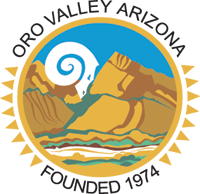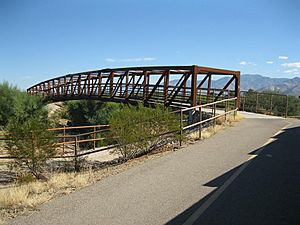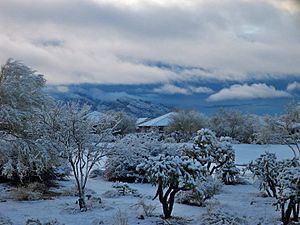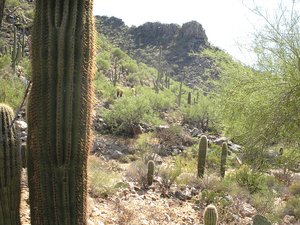Oro Valley, Arizona facts for kids
Quick facts for kids
Oro Valley, Arizona
|
||
|---|---|---|
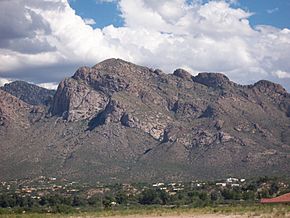
View of Pusch Ridge in the Santa Catalina Mountains from Oro Valley, September 2004
|
||
|
||
| Nickname(s):
The OV
|
||
| Country | United States | |
| State | Arizona | |
| County | Pima | |
| Founded | 1974 | |
| Incorporated | 1974 | |
| Government | ||
| • Type | Council-manager | |
| • Body | Oro Valley Town Council | |
| Area | ||
| • Total | 34.99 sq mi (90.63 km2) | |
| • Land | 34.87 sq mi (90.32 km2) | |
| • Water | 0.12 sq mi (0.30 km2) | |
| Elevation | 2,620 ft (798.57 m) | |
| Population
(2020)
|
||
| • Total | 47,070 | |
| • Density | 1,349.72/sq mi (521.13/km2) | |
| Time zone | UTC-7 (MST (no DST)) | |
| ZIP codes |
85704, 85737, 85742, 85755
|
|
| Area code(s) | 520 | |
| FIPS code | 04-51600 | |
| GNIS feature ID | 37458 | |
Oro Valley, incorporated in 1974, is a suburban town located 6 miles (9.7 km) north of Tucson, Arizona, United States, in Pima County. According to the 2010 census, the population of the town is 41,011, an increase from 29,700 in 2000. Dubbed the "Upscale Tech Mecca" of Southern Arizona by the Arizona Daily Star newspaper, Oro Valley is home to over 10 high tech firms and has a median household income nearly 50% higher than the U.S. median. The town is located approximately 110 miles (180 km) southeast of the state capital of Phoenix.
Oro Valley is situated in the western foothills of the Santa Catalina Mountains at the base of Pusch Ridge. The Tortolita Mountains are located north of the town, and vistas of the Tucson valley are to the south. The town occupies the middle Cañada del Oro Valley. Oro Valley hosts a large number of residents from around the US who maintain second or winter homes in the town.
The town hosted the 2006 Pac-10 Women's Golf Championships at the Oro Valley Country Club. Oro Valley Country Club was also the site for the 2006 Girls' Junior America's Cup, a major amateur golf tournament for the Western United States. Annual events in Oro Valley include the Oro Valley Festival of the Arts, El Tour de Tucson bicycle race, the Oro Valley Music Festival, the Tucson Marathon, the Cactus Speed Classic for inline skaters, the Oro Valley Triathlon, and the Arizona Distance Classic.
Contents
History
Pre-U.S. annexation period
The area of Oro Valley has been inhabited discontinuously for nearly two thousand years by various groups of people. The Native American Hohokam tribe lived in the Honeybee Village in the foothills of the Tortolita Mountains on Oro Valley's far north side around 500 AD. Hohokam artifacts continue to be discovered in the Honeybee Village that the Hohokam inhabited continuously for nearly 700 years, and studied by archaeologists around the globe.
Early in the 16th century, Native American tribes known as the Apache arrived in the southern Arizona area, including Oro Valley. These tribes inhabited the region only a few decades prior to the arrival of the Spanish Conquistadors, including Francisco Coronado. The Spanish established forts in the area, including the Presidio at Tucson (1775) beginning in the late 16th century.
Arizona Territorial period
Beginning in the 19th century, Americans increasingly settled in the Arizona Territory, following the Mexican-American War and the subsequent Gadsden Purchase including Southern Arizona. George Pusch, a German immigrant, settled in the area of Oro Valley in 1874, establishing a cattle ranch. This ranch was unique because it utilized a steam pump to provide water, eventually popularizing Pusch's property as the Steam Pump Ranch on the Cañada del Oro. The steam pump was one of only two in the Arizona Territory.
Pusch's ranch provided respite for settlers and travelers entering and leaving the Tucson area. Pusch Ridge is named in honor of George Pusch.
Ranching in the area continued to flourish as greater numbers of Americans settled in the Arizona Territory. Large ranching families in the Oro Valley area included the Romeros and the Rooneys.
Gold rushers into the American West also were attracted to southern Arizona, where gold was said to be in abundance in and around the Santa Catalina Mountains north of Tucson. Fueled by the legend of the lost Iron Door Gold Mine in the mountains, those in search of gold trekked through the Oro Valley area focusing their attention along the Cañada del Oro washbed.
Post-World War II period
After World War II, the Tucson area experienced dramatic population growth, impacting Oro Valley as well. In the early 1950s the Oro Valley Country Club opened at the base of Pusch Ridge, affirming the area's future as an affluent community. Although one tract housing development was built in the area in the early 1950s, the majority of homes in the Oro Valley area were built by individual land owners on large lots in a low density residential style.
Founding of the town
The community continued to grow gradually, and area residents increasingly desired local control of the land in the area. In the late 1960s, incorporation became a greater focus in Oro Valley. Tucson Mayor James M. Corbett, Jr. expressed great interest in expanding the Tucson city limits to the far north side of Pima County. Corbett vowed to bring the Oro Valley area into Tucson "kicking and screaming," alluding to the reservations Oro Valley residents expressed in joining Tucson.
A petition to incorporate began circulation in Oro Valley in 1968. The Pima County Board of Supervisors officially refused to allow Oro Valley to incorporate, and litigation followed. Ultimately, the Arizona Supreme Court ruled in favor of incorporation, and in 1974 the Town of Oro Valley was incorporated with only 2.4 square miles (6.2 km2). The original town limits included the Linda Vista Citrus Tracts, Campo Bello Estates, Shadow Mountain Estates, and Oro Valley Country Club Estates. Activity in Oro Valley centered primarily around the Oro Valley Country Club and Canyon del Oro High School. While originally referred to as Palo Verde, town founders proceeded with incorporation efforts with the official name of Oro Valley to garner support from influential residents of Oro Valley Country Club. The Town began with a population of nearly 1,200.
Through the 1980s and particularly in the 1990s Oro Valley experienced significant residential and commercial growth. In 1990 the town had a population of 6,670, and by 2000 that figure had increased to 29,700 residents. During that time, residential communities of all housing-unit densities were developed in the town, including several master-planned communities. For several years in the 1990s Oro Valley was the fastest growing municipality in Arizona.
Current state of the town
Formed by citizens of Oro Valley, the not-for-profit Oro Valley Historical Society has a mission in "preserving the Town's heritage for future generations."
Geography
Oro Valley is located at 32°25′N 110°59′W / 32.417°N 110.983°W (32.4212, -110.9760) in the middle Cañada del Oro Valley. Oro Valley sits at an average elevation of 2,620 feet (800 m) above sea level.
According to the United States Census Bureau (2000), the town has a total area of 31.9 square miles (83 km2), of which, 31.8 square miles (82 km2) of it is land and 0.1 square miles (0.26 km2) of it (0.31%) is water.
The topography of Oro Valley is distinguished by the Cañada del Oro riverbed bisecting the town. The eastern banks of the Cañada del Oro rise dramatically to the Santa Catalina Mountains. The western banks of the Cañada del Oro rise more gradually to a plateau and the foothills of the Tortolita Mountains farther north.
Notable geographic features include:
- Pusch Ridge (peak elevation: 5,361 ft.) & Pusch Ridge Wilderness Area
- Santa Catalina Mountains (peak elevation: 9,157 ft.)
- Cañada del Oro
- Tortolita Mountains (peak elevation: 4,652 ft.)
Parks
Major parks in Oro Valley include the oldest, James D. Kriegh Park (formerly Dennis Weaver Park) with an Olympic-sized swimming pool, recreational fields, and racquetball courts. The Cañada del Oro Riverfront Park features tennis and basketball courts, recreational fields, walking trails, and connections to equestrian trails along the Cañada del Oro wash. West Lambert Lane Park in Cañada Hills is a nature park with a number of hiking trails.
The Naranja Town Site is also in the planning phase, and will ultimately be the largest recreational park in Southern Arizona. The site plans include a performing arts center, aquatics center, recreational fields, tennis, basketball, tether ball, and volleyball courts, canine center, BMX and skate park. However, plans for this park have been put on hold due to the defeat of the bond issue in the November 2008 election.
Catalina State Park and the Coronado National Forest in the Santa Catalina Mountains form the eastern boundary of Oro Valley.
Linda Vista Trail, located east of Oracle Road on Linda Vista Drive, south of 1st Avenue, is a quiet, secluded, well-maintained nature trail that provides excellent views of Oro Valley, Pusch Ridge, and the surrounding vicinity.
The Oro Valley Historical Society (founded 2005), in cooperation with the Town of Oro Valley and Pima County, is working to maintain, restore, and interpret two park sites in Oro Valley.
- Honeybee Village
- Steam Pump Ranch
La Cholla Airpark (FAA 57AZ), a private airport community, is also in northwestern Oro Valley. La Cholla Airpark was founded in 1972 and includes nearly 100 residential estates. A 4,500-foot (1,400 m) air strip is situated at the center of the community for member use.
Climate
Oro Valley has very similar weather conditions as Tucson, Arizona due to how close they are to one another. However, there are small differences. Oro Valley sees slightly less rain throughout the year due to being west of the Santa Catalina Mountains and most of Tucson being south or southwest. The general temperature of Oro Valley is slightly cooler than Tucson year round due to the higher elevation. Wind tends to flow in a north, northwest direction and the sun rises later than Tucson due to the Santa Catalina Mountains.
Demographics
| Historical population | |||
|---|---|---|---|
| Census | Pop. | %± | |
| 1970 | 581 | — | |
| 1980 | 1,489 | 156.3% | |
| 1990 | 6,670 | 348.0% | |
| 2000 | 29,700 | 345.3% | |
| 2010 | 41,011 | 38.1% | |
| 2020 | 47,070 | 14.8% | |
| U.S. Decennial Census | |||
2010 census
As of the census of 2010, there were 41,011 people and 17,364 households in Oro Valley. The population density was 1,154.4 people per square mile. There were 20,340 housing units in Oro Valley. The racial makeup of the town was 81.9% non-Hispanic White, 1.5% Black or African American, 0.4% Native American, 3.1% Asian, 0.1% Pacific Islander, and 2.4% from two or more races. 11.5% of the population were Hispanic or Latino of any race.
In the town, the population was spread out, with 3.9% under the age of 5, 19.2% from 5 to 17, 50.8% from 18 to 64, and 26.1% who were 65 years of age or older. The median age was 50 years. Oro Valley was 47% male and 53% female.
The median income for a household in the town was $68,784, and the per capita income for the town was $39,397. 5.3% of the population was below the poverty line.
Sites of interest
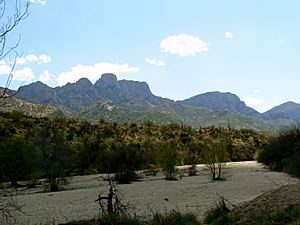
- Steam Pump Ranch: Located in the heart of Oro Valley, the Steam Pump Ranch dates back to the mid-1870s when George Pusch settled in the area. Pusch was an Arizona state legislator and delegate to the original Arizona Constitutional Convention in 1910. The ranch is in the process of being preserved by the town and includes several original buildings from the ranch itself. It was listed on the National Register of Historic Places in September 2009.
- Catalina State Park: Located on N. Oracle Road (AZ State Hwy. 77). Catalina State Park has a number of hiking and backpacking trails, including Romero Ruin Trail, Nature Trail, Romero Canyon Trail, Sutherland Trail, Canyon Loop Trail, 50-Year Trail, Birding Trail, and the Bridle Trail. Specific trails are also open to equestrians. Certain trails also connect with other trails in the Coronado National Forest, continuing to Mount Lemmon, the highest peak in the Santa Catalina Mountains at 9,157 feet (2,791 m). The park also features several campgrounds and an equestrian center.
- Immaculate Heart Preparatory School: The school is in the former mansion of Margaret Howard, the Countess of Suffolk from the United Kingdom. Built in 1937 as her winter residence, the estate is situated in the Suffolk Hills neighborhood of Oro Valley.
- Honey Bee Village: The Native American Hohokam people occupied a small community in the foothills of the Tortolita Mountains beginning around 500 AD, and the remaining ruins are preserved by the town at the original site on Oro Valley's far north side.
- Bell House: The private estate was completed in the early 1940s. Located just south of Oro Valley, the estate affords expansive views of the Tucson valley to the south. Still privately owned by the Bell family, the estate is closed to the public. Despite their claims to the contrary, the Bell family of Tucson is not descended from Alexander Graham Bell, whose only living children were daughters.
- Romero Ranch: The ruins of the large Romero Ranch are in Catalina State Park east of Oro Valley. Established in 1844 by Francisco Romero, Romero Ranch was one of the first cattle ranches near the Santa Catalina Mountains.
- Canyon del Oro High School: Construction began on the school in the early 1960s before much of the area was developed. Located in south Oro Valley and directly adjacent to Pusch Ridge, CDO is an established community center for the town.
- Oro Valley Public Library: Located in the heart of Oro Valley, on the golf course, with views of Pusch Ridge.
Economy
Innovation Park is the high-tech center of Oro Valley, featuring a number of medical and biotech campuses. Primary employers in Oro Valley include:
- Sanofi-Aventis: The world's third largest pharmaceutical company finished construction on a new 110,350-square-foot (10,252 m2) facility in Innovation Park in 2009.
- Ventana Medical Systems: The 182,000-square-foot (16,900 m2) international headquarters for the company are in Innovation Park. In 2008, Ventana was purchased by Roche Diagnostics. The firm has officially been renamed as Roche Tissue Diagnostics, maintaining "Ventana" as a brand.
- Oro Valley Hospital: The 220,000-square-foot (20,000 m2) hospital, along with a 70,000-square-foot (6,500 m2) medical office building in Innovation Park opened in 2008.
- Honeywell: Honeywell is the producer of electronic control systems and automation equipment. (The Honeywell facility is actually in unincorporated Pima County, completely surrounded by the town of Oro Valley.)
Golf and resorts
Oro Valley features several resorts and country clubs, including:
| Name | Year founded |
|---|---|
| Oro Valley Country Club |
|
| Hilton Tucson El Conquistador Golf & Tennis Resort |
|
| Oro Valley Community Center |
|
| The Golf Club at Vistoso |
|
| The Views Golf Club |
|
| The Stone Canyon Golf Club |
|
| Stone Canyon Clubhouse |
|
| Omni Tucson National Golf Resort & Spa (near Oro Valley) |
|
| Westward Look Resort |
|
| The Westin La Paloma Resort & Spa (near Oro Valley) |
|
Arts
Each winter, Musical Magic for Kids is held at the Oro Valley Town Hall, along with multiple string quartet and choral performances throughout the town.
Every April, the Oro Valley Festival of the Arts is held celebrating all forms of art and artistic expression. Live musical performances are held throughout the spring in the open-air amphitheater at Cañada del Oro Riverfront Park.
The annual Independence Day celebration is one of the largest events in Oro Valley. The Tucson Symphony Orchestra performs, along with several choirs. Fireworks shows and concerts are also provided by the Hilton El Conquistador Resort.
The Oro Valley Music Festival is an annual outdoor music festival held over two days at the Golf Club at Vistoso, typically during the first weekend of October. The 2017 lineup included artists such as Gavin DeGraw, Lee Brice, LeAnn Rimes, Brothers Osborn and Echosmith.
Public art is exhibited throughout the year at the Oro Valley Hospital in Rancho Vistoso. A number of sculptures, murals, and statues of public art are featured throughout Oro Valley.
Education
Public schools in Oro Valley are administered by Amphitheater Public Schools of Tucson. Oro Valley is served by five public elementary schools, two K-8 schools, one middle school, and two high schools (Canyon del Oro High School and Ironwood Ridge High School).
Public schools serving Oro Valley include:
| School | Year founded |
|---|---|
| Canyon del Oro High School |
|
| Ironwood Ridge High School |
|
| Richard B. Wilson K-8 School |
|
| Coronado K-8 School |
|
| L.W. Cross Middle School |
|
| Copper Creek Elementary School |
|
| Painted Sky Elementary School |
|
| Innovation Academy STEM School |
|
| Mesa Verde Elementary School |
|
| Winifred Harelson Elementary School |
|
Oro Valley also has two charter schools, BASIS Schools Oro Valley (K-12) and Leman Academy of Excellence (K-8). The Basis school made Newsweek's list of the top ten high schools in the nation, coming in #3 in United States. Oro Valley also has three private schools, Casas Christian School (K-8), Pusch Ridge Christian Academy (K-12), and Immaculate Heart Preparatory School (K-12).
Transportation
Oro Valley is served by Sun Shuttle service to Tucson.
Notable people
- Alex Bowman – professional stock car racing driver
- Ka'Deem Carey – professional football player
- Brian Disbury – English first-class cricketer, lived in Oro Valley until his death in 2016
- Chris Duncan – professional baseball player
- Shelley Duncan – baseball player
- Scott Hairston – professional baseball player
- Ian Kinsler – Israeli-American professional baseball player
- Blake Martinez – professional football player
- E. William Quirin - businessman and Minnesota state legislator
- Lionel Sanders – professional triathlete
Images for kids
See also
 In Spanish: Oro Valley (Arizona) para niños
In Spanish: Oro Valley (Arizona) para niños


